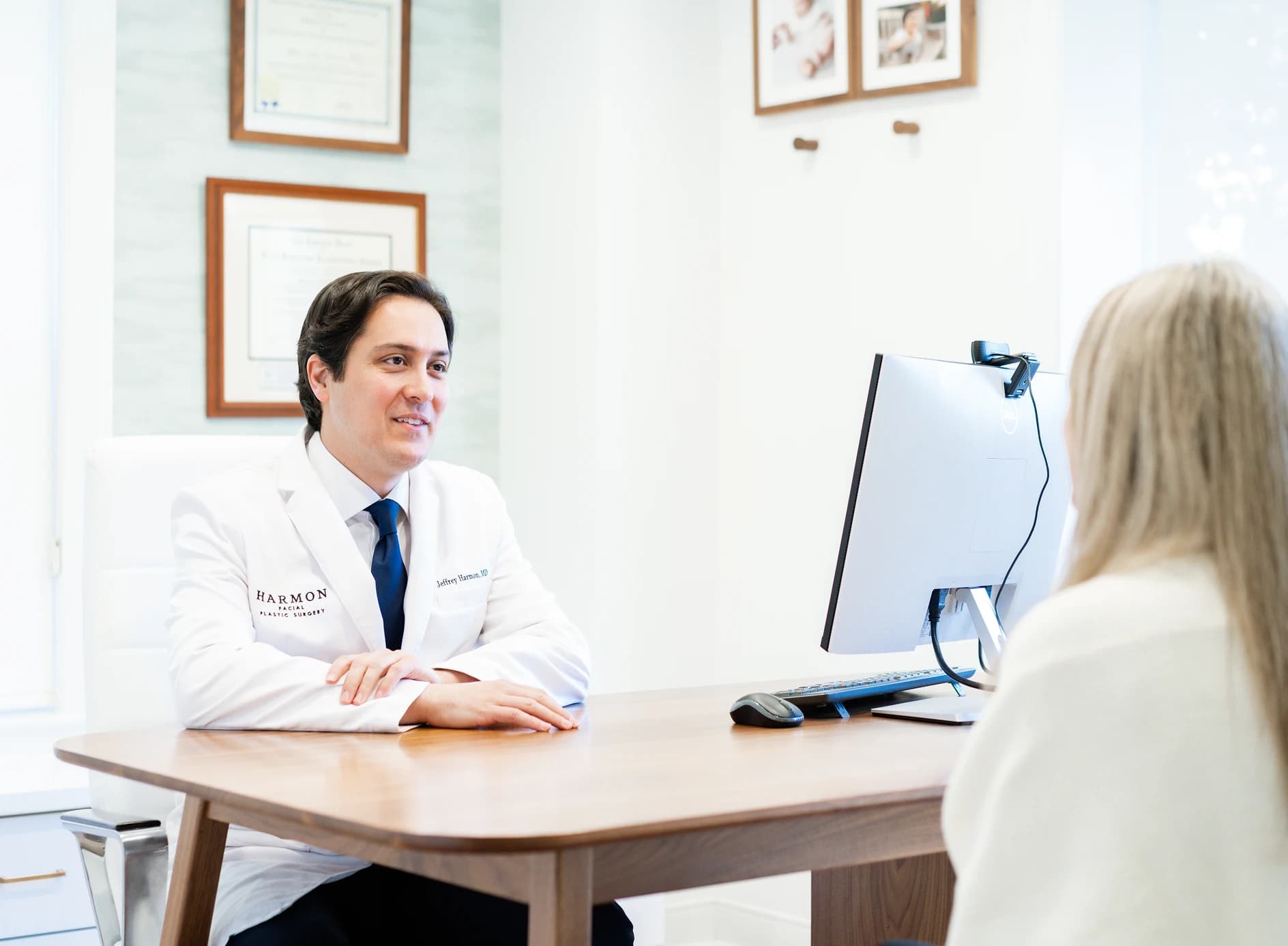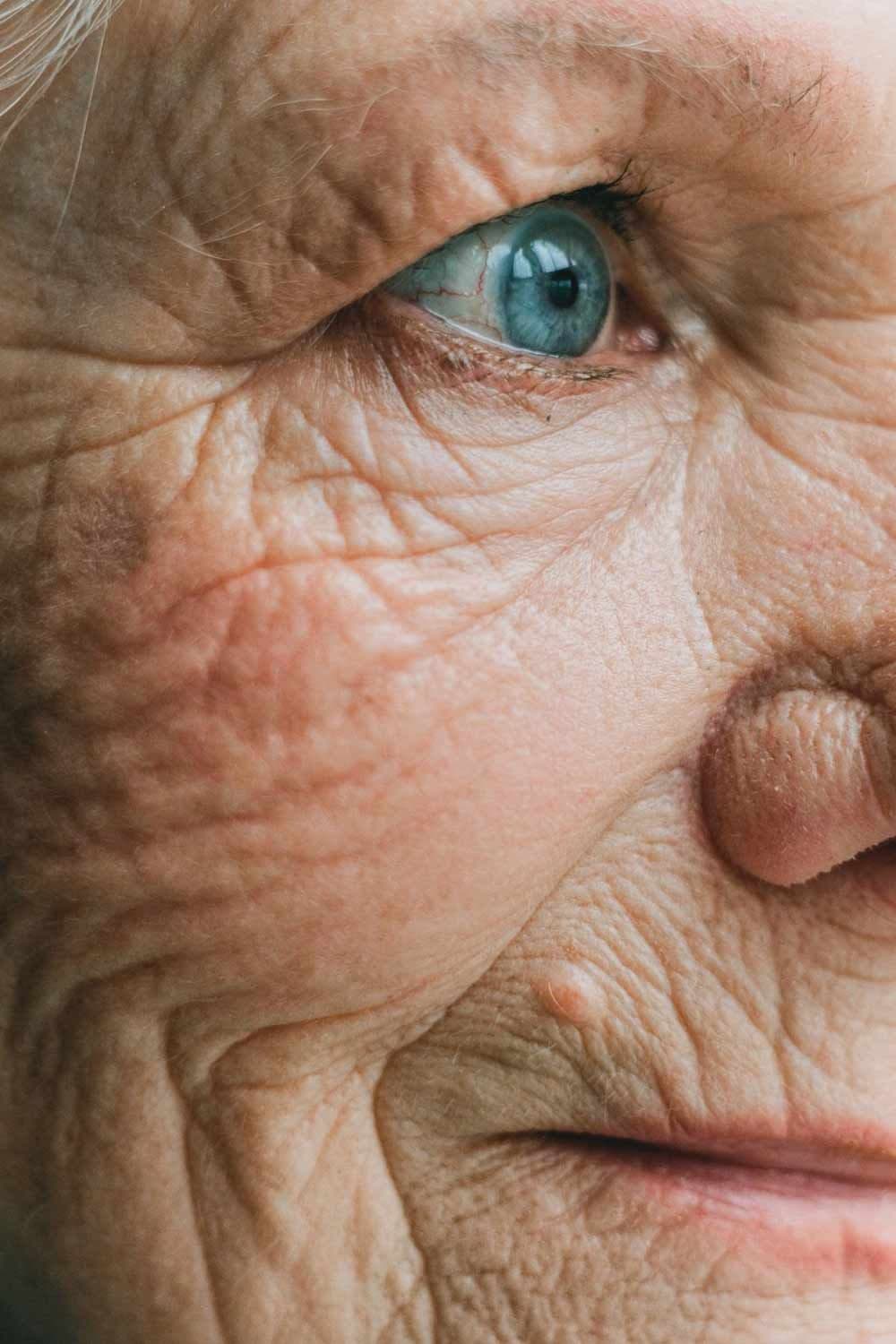Laser Skin Resurfacing
- A fractional laser helps reduce downtime
- Dr. Harmon uses both topical and injected local anesthesia to minimize discomfort during the procedure
Contact Us
What is Laser Skin Resurfacing?
Laser skin resurfacing is a non-surgical procedure in which a fractional ablative CO2 laser is used to vaporize skin at a depth of micrometers, thereby inducing the body to generate a signaling cascade intended to help the skin heal in a more youthful manner. A CO2 laser is one of two types of lasers that ablate or vaporize skin. A fractional ablative CO2 laser does not treat the entire surface of the skin. Instead, it treats a certain percentage of the skin surface by sending microcolumns of laser energy between which untreated skin is left to improve the healing process. The purpose of utilizing a fractional laser is not only to improve the healing process and reduce downtime after treatment, but also to reduce the risks associated with the laser. More than one treatment may be required to achieve optimal results.
What Conditions Does the Procedure Address?
Laser skin resurfacing utilizing a fractional ablative CO2 laser helps address age-related changes to the skin surface. It can also help with addressing scars. The conditions laser skin resurfacing can help address include:
Fine lines and wrinkles secondary to age and environmental factors such as chronic sun exposure and smoking
Hyperpigmented age spots on the face
Textural inconsistencies on the skin of the face
Large pores on the face
Scaring on the face secondary to trauma, surgery, and/or acne
Before & After
Explore our galleries to see the stunning, natural results Dr. Harmon delivers.
Why Choose Dr. Harmon
The desire for youthfulness is understandable. There is no area more important than the face. After all, the face cannot be hidden. It is how we present ourselves to the world. Dr. Harmon works with a refined eye and trained hands to develop a personalized treatment plan with you, utilizing advanced techniques in surgical and non-surgical care of the face, nose, eyes, neck and hair.
Fellowship trained facial plastic surgeons have a unique specialized skill set in performing surgical and non-surgical procedures on the face, nose, eyes, neck and hair. The pathway to becoming a facial plastic surgeon begins with five years of rigorous training in head and neck surgery. This training is focused on all aspects of surgery for the head and neck, in addition to aesthetic and reconstructive procedures.
A small pool of top performing graduates from head and neck surgery programs are then selected to complete sub-specialty training as a fellow in facial plastic and reconstructive surgery through the American Academy of Facial Plastic and Reconstructive Surgery (AAFPRS).
Dr. Harmon completed his fellowship in facial plastic surgery through the AAFPRS with the world-renowned facial plastic surgeon Dr. Andrew Jacono on Park Avenue in New York City. Dr. Jacono is world renowned for developing the extended deep plane facelift technique. Dr. Harmon is one of the few surgeons in the world, and the only surgeon in the Cincinnati area, fellowship trained in this technique by Dr. Jacono.
Quad A Accredited Surgery Suite
Harmon Facial Plastic Surgery is proud to have a Quad A accredited operating room and facility in our office. Our single-physician, single-specialty facility meets or exceeds the strict guidelines and high standards set forth by Quad A, demonstrating our strong commitment to patient safety and excellence in surgical care. We utilize the services of board-certified anesthesiology physicians only as well as our own personal clinical support staff to ensure the most comfortable, safest experience for our clients.
Overview of the Procedure
The team at Harmon Facial Plastic Surgery works tirelessly to prepare patients well for their procedure. The time spent with patients and resources provided facilitates a smooth transition from the procedure through recovery. The following overview is a broad summary of the information provided to patients:
Procedure Consultation
Expect a detailed, informative discussion with Dr. Harmon about your concerns and aesthetic goals. He will develop a personalized treatment plan to address these concerns and goals.
Pre-Treatment Preparation
There is no specific pre-treatment preparation necessary prior to treatment. However, there may be some surgical or non-surgical treatments that could dictate the time frame in which laser skin resurfacing can be administered. It is also ideal to avoid blood thinning medications such as nonsteroidal anti-inflammatory drugs (NSAIDs) such as ibuprofen for one week prior to treatment if possible.
Day of Treatment
Patients are instructed to arrive at the office in comfortable clothes. The treatment plan is discussed with the patient in detail. Paperwork is completed. Photos are usually taken pre-operatively. Finally, the patient meets the surgical team, which may include nurses, anesthesiologists, and/or scrub technologists, depending on the procedure(s) and type of anesthesia used.
Follow-Up Appointment
Patients usually follow up in approximately one (1) week to evaluate healing. Post-treatment instructions are discussed again at this appointment. The next visit is approximately three (3) months after treatment. Additional follow-up appointments depend on how healing has progressed.
Social Readiness
Patients are applying a thick emollient such as Vaseline® for the first approximately seven (7) to ten (10) days after treatment. Patients are then instructed to apply moisturizer and sunscreen after discontinuing use of the emollient. It is at this time that makeup can generally be worn. Most patients report feeling comfortable socializing by approximately ten (10) days after treatment.
Before & After
Explore our galleries to see the stunning, natural results Dr. Harmon delivers.
Ideal Candidates for Laser Skin Resurfacing
Ideal candidates for laser skin resurfacing include those patients who demonstrate facial skin with:
-
Fine lines and wrinkling
-
Age spots
-
Large pores
-
Textural abnormalities
-
Scars secondary to trauma, surgery, and/or acne
A consultation is essential to determine candidacy for the procedure, because there may be factors that preclude this procedure for certain individuals. For example, certain skin types may not be good candidates for this procedure. Reasonable expectations must be established about what laser skin resurfacing can and cannot accomplish as with all plastic surgery procedures. For example, more than one treatment may be required for optimal results.
What to Expect from Recovery
Recovery from laser skin resurfacing is specific to the individual. The duration of recovery will vary from person to person.
The initial recovery time for this procedure is approximately seven (7) to ten (10) days for most individuals. Some swelling and redness are expected. Also, the areas treated with the laser may appear as small spots that range in color from white to brown. These spots peel off gradually over the first few days as patients wash their face.
The skin may have a rough texture early in the recovery as well. Makeup can be applied after this initial recovery. It is extremely important to avoid sun exposure by using hats and sunscreen for approximately three (3) months after treatment.
Initial recovery
Avoid sun exposure by using hats and sunscreen
Benefits of Laser Skin Resurfacing
Laser skin resurfacing helps address many features of age-related changes to the skin of the face. It can help:
-
Fine lines and wrinkles
-
Age spots
-
Textural abnormalities
-
Large pores
-
Scars
Risks of Laser Skin Resurfacing
The potential risks of laser skin resurfacing include, but are not limited to:
-
Swelling
-
Redness
-
Infection
-
Skin pigmentary changes
-
Scaring
-
Eye injury
Combine Laser Skin Resurfacing with Other Facial Enhancements
Laser skin resurfacing complements other surgical and non-surgical procedures well. Surgical procedures help address drooping tissue and volume shifts that occur with age. Laser skin resurfacing targets areas the surgical procedures do not address. Similarly, the non-surgical procedures listed below address features of facial aging that that laser skin resurfacing does not address. Procedures that complement laser skin resurfacing include, but are not limited to:
Deep Plane Facelift
While a deep plane facelift lifts and repositions deeper tissues, laser resurfacing helps refine the skin’s surface. Combined, they may rejuvenate both structure and skin quality for a comprehensive transformation.
Brow Lift
A brow lift can elevate and open the upper face, and when paired with laser resurfacing, it can enhance skin tone and texture, supporting a smoother forehead and brow appearance.
Blepharoplasty
Laser resurfacing can smooth fine lines and even skin tone around the eyes, making it a natural companion to blepharoplasty to help brighten the eye area for a more youthful look.
Facial Fat Grafting
Fat grafting may restore volume and contour, while laser resurfacing can improve skin clarity. Combining both may help address multiple dimensions of facial aging for a revitalized, natural appearance.
Fillers
Fillers restore volume beneath the skin, while laser resurfacing improves the skin’s outer texture. Used together, they help provide both smoothness and fullness for refreshed, balanced results.
Botox©
Botox© relax expression lines, and laser resurfacing enhances skin tone and clarity. Together, they may create a more youthful, refined appearance with improved skin quality and smoother expression.

Book Your Consultation
Take the first step toward your aesthetic goals with a personalized consultation. Dr. Harmon will listen to your concerns, answer your questions, and guide you through your options. Schedule your consultation today and discover how expert care can make a difference.
Read More About Laser Skin Resurfacing

Cosmetic Laser Treatments: An Explainer
Laser treatments can address specific concerns about the skin on the face and neck. It is important to seek not only a fellowship-trained but also a...

Skin Care After Laser Resurfacing of the Face
Laser resurfacing of the face can address wrinkles and other irregularities of the tone and texture of the skin resulting in a softer, more youthful...
Addressing Smoker’s Lines (Peri-Oral Rhytids)
One of the most common concerns people express about their face as they age is the presence of smoker's lines, or peri-oral rhytids, around the...
FAQ
Who performs laser resurfacing procedures at Harmon Facial Plastic Surgery?
Dr. Jeffrey Harmon performs all laser resurfacing procedures himself. Dr. Harmon has the detailed understanding of facial anatomy and the experience as a fellowship-trained facial plastic surgeon to provide the safest, most effective treatment.
Do I need to treat my entire face or can I treat individual locations?
Individual locations on the face can be treated. The forehead, cheeks, peri-oral skin (smoker’s lines), and lower eyelids are areas that are commonly treated individually.
Can the fractional CO2 laser be used with other procedures?
Yes. In fact, the fractional CO2 laser can enhance the results of other procedures. For example, the fractional CO2 laser can be used with the extended deep plane facelift, which is unique among facelift techniques. This is because the lifted tissue is thicker, healthier, and more resilient, making the skin safer for treatment.
What is the best time of the year to undergo laser resurfacing?
You can undergo laser resurfacing with the fractional CO2 laser at any time of the year as long as you can carefully avoid exposure to the sun through the use of hats and sunscreen for approximately 3 months after treatment.
Can laser resurfacing (CO2 Procedure) be used on all skin types?
The procedure is not appropriate for individuals with more pigmented skin tones because of an increased risk of skin lightening in the areas of treatment with this procedure.
What type of anesthesia is required?
Laser resurfacing can generally be performed comfortably with either local anesthesia or IV sedation.
How does laser resurfacing work?
The resurfacing laser used at Harmon Facial Plastic Surgery is called a fractional CO2 laser. This type laser has been in use for many years, becoming safer and more effective as the technology has advanced. The laser reaches the skin in micro-columns, leaving intact skin between the treatment areas. The treated areas form new, more youthful collagen as they heal. The intact skin provides stem cells to enhance the healing process.
How does Dr. Harmon’s approach differ from other plastic and facial plastic surgeons?
Dr. Harmon trained in New York City with one of the world’s premier facial plastic surgeons, Dr. Andrew Jacono. As a result, he offers innovative, cutting-edge techniques in facial rejuvenation. One example of this is Dr. Harmon’s approach to improving smoker’s lines, the vertical wrinkles around the mouth that develop as we age. These lines can be quite deep and stubborn to treat. Dr. Harmon utilizes the body’s own fat, transforming it into fine nano-fat in an effort to induce changes in the tissue at these locations to improve their appearance, prior to treating the area with the fractional CO2 laser. The nano-fat can improve lines around the mouth in a way - increasing the thickness of the layer of skin called the dermis - that using hyaluronic acid filler or the fractional CO2 laser alone cannot. In other words, this technique can treats smoker’s lines utilizing the body’s own fat to enhance the results of the laser.
Written by Dr. Harmon
Discover the expertise and compassionate care of Dr. Jeff Harmon, a fellowship-trained facial plastic surgeon deeply rooted in the Cincinnati community. A former collegiate athlete and Cornell University graduate, Dr. Harmon brings discipline, precision, and a global perspective to his surgical practice—refined through elite fellowship training in New York City.
Located in Hyde Park, Harmon Facial Plastic Surgery proudly serves patients throughout the Cincinnati area offering personalized facial aesthetics with world-class skill and a hometown heart.